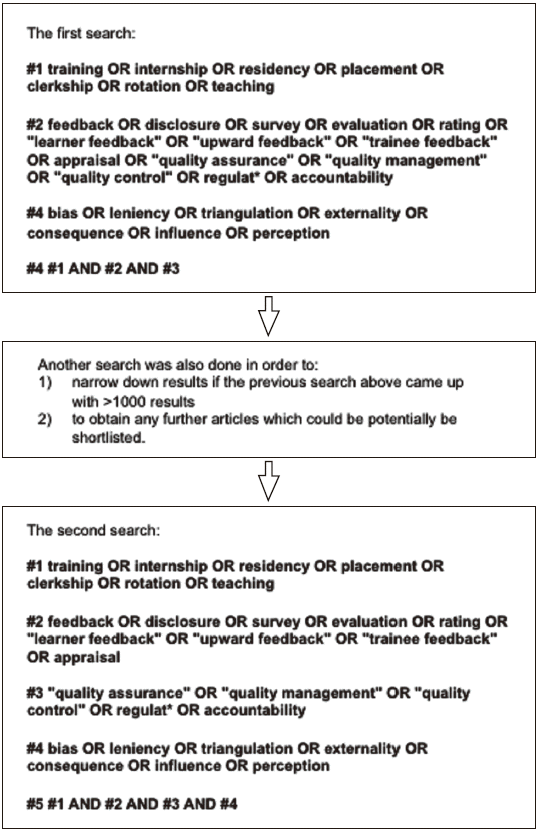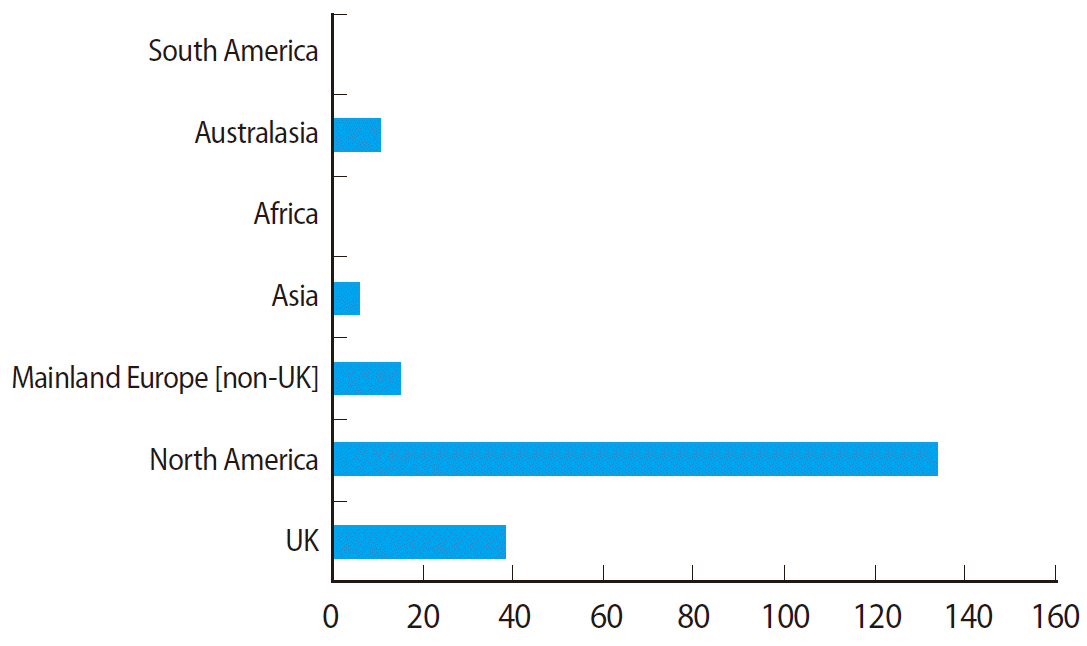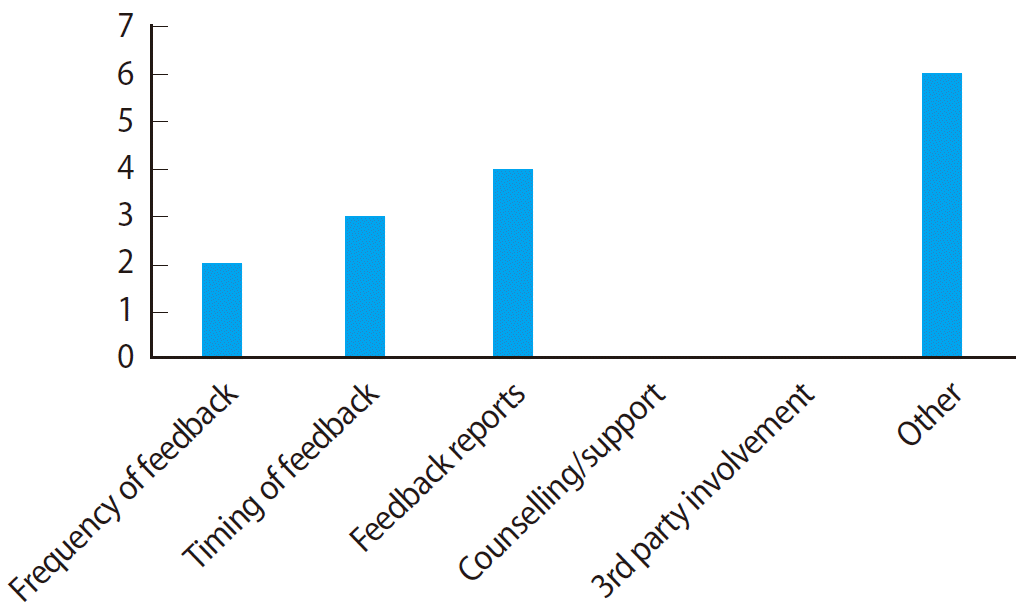2. Marsh HW, Roche L. The use of students’ evaluations and an individually structured intervention to enhance university teaching effectiveness. Am Educ Res J. 1993; 30:217–251.
http://dx.doi.org/10.3102/00028312030001217.

7. Brockx B, Spooren P, Mortelmans D. Taking the grading leniency story to the edge: the influence of student, teacher, and course characteristics on student evaluations of teaching in higher education. Educ Assess Eval Account. 2011; 23:289–306.
http://dx.doi.org/10.1007/s1109201191262.

12. Barrow P, Baker P. Factors that affect upward feedback in general surgery registrar training. 2013; (unpublished data).
17. Kudisch JD, Fortunato VJ, Smith AF. Contextual and individual difference factors predicting individuals’ desire to provide upward feedback. Group Organ Manage. 2006; 31:503–529.
http://dx.doi.org/10.1177/1059601106286888.

18. Kirkpatrick DL. Techniques for evaluating training programs. Train Dev J. 1979; 33:78–92.
21. Adams MJ, Umbach PD. Nonresponse and online student evaluations of teaching: understanding the influence of salience, fatigue, and academic environments. Res High Educ. 2011; 53:576–591.
http://dx.doi.org/10.1007/s1116201192405.

23. Gross J, Lakey B, Edinger K, Orehek E, Heffron D. Person perception in the college classroom: accounting for taste in students’ evaluations of teaching effectiveness. J Appl Soc Psychol. 2009; 39:1609–1638.
http://dx.doi.org/10.1111/j.15591816.2009.00497.x.

24. Remedios R, Lieberman DA. I liked your course because you taught me well: the influence of grades, workload, expectations and goals on students’ evaluations of teaching. Br Educ Res J. 2008; 34:91–115.
http://dx.doi.org/10.1080/01411920701492043.

25. Chen Y, Hoshower LB. Student evaluation of teaching effectiveness: an assessment of student perception and motivation. Assess Eval High Educ. 2003; 28:71–88.
http://dx.doi.org/10.1080/02602930301683.

26. Worthington AC. The impact of student perceptions and characteristics on teaching evaluations: a case study in finance education. Assess Eval High Educ. 2002; 27:49–64.
http://dx.doi.org/10.1080/02602930120105054.

29. Marsh HW. Multidimensional ratings of teaching effectiveness by students from different academic settings and their relation to student/course/instructor characteristics. J Educ Psychol. 1983; 75:150–166.
http://dx.doi.org/10.1037/00220663.75.1.150.

30. Marsh HW, Roche L. Effects of grading leniency and low workload on students’ evaluations of teaching: popular myth, bias, validity, or innocent bystanders? J Educ Psychol. 2000; 92:202–228.
http://dx.doi.org/10.1037/00220663.92.1.202.

32. Goos M, Gannaway D, Hughes C. Assessment as an equity issue in higher education: comparing the perceptions of first year students, course coordinators, and academic leaders. Aust Educ Res. 2011; 38:95–107.
http://dx.doi.org/10.1007/s1338401000082.

38. Theall M, Franklin J. Looking for bias in all the wrong places: a search for truth or a witch hunt in student ratings of instruction? New Dir Inst Res. 2001; 109:45–56.
http://dx.doi.org/10.1002/ir.3.

39. Feldman KA. The significance of circumstances for college students’ ratings of their teachers and courses. Res High Educ. 1979; 10:149–172.
http://dx.doi.org/10.1007/BF00976227.

40. Sojka J, Gupta AK, DeeterSchmelz DR. Student and faculty perceptions of student evaluations of teaching: a study of similarities and differences. Coll Teach. 2002; 50:44–49.
http://dx.doi.org/10.1080/87567550209595873.

41. Berk RA. Survey of 12 strategies to measure teaching effectiveness. Int J Teach Learn High Educ. 2005; 17:48–62.
46. Aleamoni LM. Student rating myths vs research from 19241998. J Pers Eval Educ. 1999; 13:153–166.
48. Tews MJ, Tracey JB. Enhancing formal interpersonal skills training through posttraining supplements. Cornell Hosp Q. 2007; 7:4–20.
49. Tews MJ, Tracey JB. Helping managers help themselves: the use and utility of onthejob interventions to improve the impact of interpersonal skills training. Cornell Hosp Q. 2009; 50:245–258.
http://dx.doi.org/10.1177/1938965509333520.
52. Kember D, Leung D. Development of a questionnaire for assessing student’s perceptions of the teaching and learning environment and its use in quality assurance. Learn Environ Res. 2009; 12:15–29.
http://dx.doi.org/10.1007/s1098400890507.

53. Scott A, Jeon SH, Joyce CM, Humphreys JS, Kalb G, Witt J, Leahy A. A randomised trial and economic evaluation of the effect of response mode on response rate, response bias, and item nonresponse in a survey of doctors. BMC Med Res Methodol. 2011; 11:126–138.
http://dx.doi.org/10.1186/1471228811126.

58. Albanese M. Rating educational quality: factors in the erosion of professional standards. Acad Med. 1999; 74:652–658.
60. Eva KW, Armson H, Holmboe E, Lockyer J, Loney E, Mann K, Sargeant J. Factors influencing responsivenss to feedback: on the interplay between fear, confidence, and reasoning processes. Adv Health Sci Educ Theory Pract. 2012; 17:15–26.
http://dx.doi.org/10.1007/s1045901192907.
63. GravaGubins I, Scott S. Effects of various methodologic strategies: survey response rates among Canadian physicians and physicansintraining. Can Fam Physician. 2008; 54:1424–1430.
68. Antonioni D. Predictors of upward feedback ratings. J Manage Issues. 1999; 11:26–36.
70. Westerman JW, Rosse JG. Reducing the threat of rater nonparticipation in 360degree feedback systems: an exploratory examination of antecedents to participation in upward ratings. Group Organ Manage. 1997; 22:288–309.
http://dx.doi.org/10.1177/1059601197222008.
77. Henderson A, Beattie H, Boyde M, Storrie K, Lioyd B. An evaluation of the first year of a collaborative tertiaryindustry curriculum as measured by students perceptions of their clinical learning environment. Nurse Educ Pract. 2006; 6:207–213.
http://dx.doi.org/10.1016/j.nepr.2006.01.002.
81. Cohan JA. “I didn’t know” and “I was only doing my job”: has corporate governance careened out of control? A case study of Enron’s information myopia. J Bus Ethics. 2002; 40:275–299.
http://dx.doi.org/10.1023/A:1020506501398.
82. Palmgren PJ, Chandratilake M. Perception of educational environment among undergraduate students in a chiropractic training institution. J Chiropract Educ. 2011; 25:151–163.
http://dx.doi.org/10.7899/1042505525.2.151.

87. Paul P, Olson J, Jackman D, Gauthier S, Gibson B, Kabotoff W, Weddell A, Hungler K. Perceptions of extrinsic factors that contribute to a nursing internship experience. Nurse Educ Today. 2011; 31:763–767.
http://dx.doi.org/10.1016/j.nedt.2010.11.016.

89. Brugnolli A, Perli S, Viviani D, Saiani L. Nursing students’ perceptions of tutorial strategies during clinical learning instructions. Nurse Educ Today. 2011; 31:152–156.
http://dx.doi.org/10.1016/j.nedt.2010.05.008.
97. Turnball C, Baker P, Allen S. A comparison of three different quality assurance systems for higher medical training. Clin Med. 2007; 7:486–491.

98. Biller CK, Antonacci AC, Pelletier S, Homel P, Spann C, Cunningham MJ, Eavey RD. The 80hour work guidelines and resident survey perceptions of quality. J Surg Res. 2006; 135:275–281.
http://dx.doi.org/10.1016/j.jss.2006.04.010.

100. Brasher AE CS, Hauge LS, Prinz RA, Neumayer LA, Baker CC, Soybel DI, Freischlag JA, Jeekel JH. Medical students’ perceptions of resident teaching: have duty hours regulations had an impact? Ann Surg. 2005; 242:548–555.
http://dx.doi.org/10.1097/01.sla.0000184192.74000.6a.
101. Busari JO, Wegglaar NM, Knottnerus AC, Greidanus PM, Scherpbier AJ. How medical residents perceieve the quality of supervision provided by attending doctors in the clinical setting. Med Educ. 2005; 39:696–703.
http://dx.doi.org/10.1111/j.13652929.2005.02190.x.
102. Ansari WE, Oskrochi R. What ‘really’ affects health professions students’ satisfaction with their educational experience? Implications for practice and research. Nurse Educ Today. 2004; 24:644–655.
http://dx.doi.org/10.1016/j.nedt.2004.09.002.
103. Basu CB, Chen LM, Hollier LH Jr, Shenaq SM. The effect of the accreditation council for graduate medical education duty hours policy on plastic surgery resident education and patient care: an outcomes study. Plast Reconstr Surg. 2004; 114:1878–1886.
http://dx.doi.org/10.1097/01.PRS.0000142768.07468.64.

107. Barrett E, Barry H, Guruswamy S, McCarthy M, Kavanagh E. What trainees really think: the 2009 and 2010 national trainee survey of trainees’s perception of their training in Ireland. In : In: 20th European Congress of Psychiatry; 2012 Mar 3-6; Prague, Czech Republic.
108. Steiner IP, Yoon PW, Kelly KD, Diner BM, Blitz S, Donoff MG, Rowe BH. The influence of residents training level on their evaluation of clinical teaching faculty. Teach Learn Med. 2005; 17:42–48.
http://dx.doi.org/10.1207/s15328015tlm1701_8.

110. Berber M. How can faculty course survey be made more meaningful? Surv Land Inf Sci. 2011; 71:13–19.
112. Antiel R, Van Arendonk K, Reed D, Terhune JP, Tarpley JL, Porterfield JR, Hall DE, Joyce DL, Wightman SC, Horvath KD, Heller SF, Farley DR. Surgical training, duty-hour restrictions, and implications for meeting the accreditations council for graduate medical education core competencies: views of surgical interns compared with program directors. Arch Surg. 2012; 147:536–541.
http://dx.doi.org/10.1001/archsurg.2012.89.

114. Ratanawongsa N, Bolen S, Howell EE, Kern D, Sisson S, Larriviere D. Residents’ perceptions of professionalism in training and practice: barriers, promoters, and duty hour requirements. J Gen Intern Med. 2006; 21:758–763.
http://dx.doi.org/10.1111/j.15251497.2006.00496.x.

115. Thangaratinam S, Yanamandra SR, Deb S, Coomarasamy A. Specialist training in obstetrics and gynaecology: a survey on worklife balance and stress among trainees in UK. J Obstet Gynaecol. 2006; 26:302–304.
http://dx.doi.org/10.1080/01443610600594773.

116. Kanashiro J, McAleer S, Roff S. Assessing the educational environment in the operating room: a measure of resident perception at one Canadian institution. Surgery. 2006; 139:150–158.
http://dx.doi.org/10.1016/j.surg.2005.07.005.
120. Watling C, Kenyon CF, Zibrowski EM, Schulz V, Goldszmidt MA, Singh I, Maddocks HL, Lingard L. Rules of engagement: residents’ perceptions of the intraining evaluation process. Acad Med. 2008; 83:S97–S100.
http://dx.doi.org/10.1097/ACM.0b013e318183e78c.

121. Cannon G, Keitz S, Holland G, Chang B, Byrne J, Tomolo A, Aron DC, Wicker AB, Kashner TM. Factors determining medical students’ and residents’ satisfaction during VAbased training: Findings from the VA learners’ perceptions survey. Acad Med. 2008; 83:611.
http://dx.doi.org/10.1097/ACM.0b013e3181722e97.

122. Pearce I, Royle J, O’Flynn K, Payne S. The record of intraining assessments (RITAs) in urology: an evaluation of trainee perceptions. Ann R Coll Surg Engl. 2003; 85:351–354.
http://dx.doi.org/10.1308/003588403769162495.

123. Conigliaro J, Frishman WH, Lazar EJ, Creons L. Internal medicine housestaff and attending physician perceptions of the impact of the New York State Section 405 regulations on working conditions and supervision of residents in two training programs. J Gen Intern Med. 1993; 8:502–507.
http://dx.doi.org/10.1007/BF02600112.

125. Yarris L, Linden J, Hern G, Lefebvre C, Nestler DM, Fu R, Choo E, LaMantia J, Burnett P; Emergency Medicine Education Research Group. Attending and resident satisfaction with feedback in the emergency department. Acad Emerg Med. 2009; 16:S76–S78.
http://dx.doi.org/10.1111/j.15532712.2009.00592.x.

126. Sargeant J, Mann K, Sinclair D, Van der vleuten C, Metsemakers J. Understanding the influence of emotions and reflection upon multisource feedback acceptance and use. Adv Health Sci Educ Theory Pract. 2008; 13:275–288.
http://dx.doi.org/10.1007/s104590069039x.

128. Sender Liberman A, Liberman M, Steinert Y, Mcleod P, Meterissian S. Surgery residents and attending surgeons have different perceptions of feedback. Med Teach. 2005; 27:470–472.
http://dx.doi.org/10.1080/0142590500129183.

129. Johnson NR, Chen J. Medical student evaluation of teaching quality between obstetrics and gynaecology residents and faculty as clinical preceptors in ambulatory gynaecology. Am J Obstet Gynecol. 2006; 195:1479–1483.
http://dx.doi.org/10.1016/j.ajog.2006.05.038.
132. O’Brien M, Brown J, Ryland I, Shaw N, Chapman T, Gillies R, Graham D. Exploring the views of secondyear Foundation Programme doctors and their educational supervisors during a deanarywide pilot Foundation Programme. Postgrad Med J. 2006; 82:813–816.
http://dx.doi.org/10.1136/pgmj.2006.049676.
133. Claridge J, Forrest Calland J, Chandrasekhara V, Young JS, Sanfey H, Schirmer BD. Comparing resident measurements to attending surgeons selfperceptions of surgical educators. Am J Surg. 2003; 185:323–327.
http://dx.doi.org/10.1016/S00029610(02)014216.
134. Robbins TL, DeNisi AS. A closer look at interpersonal affect as a distinct influence on coginitive processing in performance evaluations. J Appl Psychol. 1994; 79:341–353.
http://dx.doi.org/10.1037/00219010.79.3.341.
135. Ramsey PG, Gillmore GM, Irby DM. Evaluating clinical teaching in medicine clerkship: relationship of instructor experience and training setting to ratings of tutor effectiveness. J Gen Intern Med. 1988; 3:351–355.
136. Hayward RA, Williams BC, Gruppen LD, Rosenbaum D. Measuring attending physician performance in a general medicine outpatient clinic. J Gen Intern Med. 1995; 10:504–510.
http://dx.doi.org/10.1007/BF02602402.

142. Ryland I, Brown J, O’Brien M, Graham D, Gillies R, Chapman T, Shaw N. The portfolio: how was it for you? Views of F2 doctors from the Mersey Deanery Foundation Pilot. Clin Med. 2006; 6:378–380.

143. Watling C, Lingard L. Toward meaningful evaluation of medical trainees: The influence of participants’ perceptions of the process. Adv Health Sci Educ Theory Pract. 2010; 17:183–194.
http://dx.doi.org/10.1007/s104590109223x.

144. Tochel C, Haig A, Hesketh A, Cadzow A, Beggs K, Colthart I, Peacock H. The effectiveness of portfolios for post-graduate assessment and education: BEME Guide No.12. Med Teach. 2009; 31:299–318.
http://dx.doi.org/10.1080/01421590902883056.
145. Rose JS, Waibel BH, Schenarts PJ. Disparity between resident and faculty surgeons’ perceptions of preoperative preparation, intraoperative teaching, and postoperative feedback. J Surg Educ. 2011; 68:459–464.
http://dx.doi.org/10.1016/j.jsurg.2011.04.003.

146. Govaerts M, Van Der Vleuten C, Schuwirth L, Muijtjens A. The use of observational diaries in intraining evaluation: student perceptions. Adv Health Sci Educ Theory Pract. 2005; 10:171–188.
http://dx.doi.org/10.1007/s1045900503985.

149. Surratt CK, Desselle SP. Pharmacy students’ perceptions of a teaching evaluation process. Am J Pharm Educ. 2007; 71:6.

152. Fallon SM, Creon LG, Shelov SP. Teachers’ and students’ ratings of clinical teaching and teachers’ opinions on use of student evaluations. Med Educ. 1987; 62:435–438.

153. Stritter FT, Hain JD, Grimes DA. Clinical teaching reexamined. J Med Educ. 1975; 62:1–7.

158. Irby D, Rakestraw P. Evaluating clinical teaching in medicine. Med Educ. 1981; 56:181–186.

161. De SK, Henke PK, Ailawadi G, Dimick JB, Colletti LM. Attending, house officer, and medical student perceptions about teaching in the thirdyear medical student perceptions about teaching in the thirdyear medical school general surgery clerkship. J Am Coll Surg. 2004; 199:932–942.
http://dx.doi.org/10.1016/j.jamcollsurg.2004.08.025.
163. Tiberius RG, Sackin HD, Slingerland JM, Jubas K, Bell M, Matlow A. The influence of student evaluative feedback on the improvement of clinical teaching. J High Educ. 1989; 60:665–681.

167. Henzi D, Davis E, Jasinevicius R, Hendricson W, Clintron L, Isaacs M. Appraisal of the dental school learning environment: the students’ view. J Dental Educ. 2005; 69:1137–1147.

176. Keitz S, Gilman S, Breen A, Graber M. Measuring the quality of veterans affairs (VA) clinical training: a learners perception survey of medical residents in VA medical centres. J Gen Intern Med. 2002; 17:228.
177. Moalem J, Salzman P, Ruan DT, Cherr GS, Freiburg CB, Farkas RL, Brewster L, James TA. Should all duty hours be the same? Results of a national survey of surgical trainees. J Am Coll Surg. 2009; 209:47–54. 54.el–2.
http://dx.doi.org/10.1016/j.jamcollsurg.2009.02.053.

178. Sargeant J, McNaughton E, Mercer S, Murphy D, Sullivan P, Bruce DA. Providing feedback: exploring a model (emotion, content, outcomes) for facilitating multisource feedback. Med Teach. 2011; 33:744.
http://dx.doi.org/10.3109/0142159X.2011.577287.

179. Schuh LA, Khan MA, Harle H, Southerland AM, Hicks WJ, Falchook A, Schultz L, Finney GR. Pilot trial of IOM duty hour recommendations in neurology residency programs: unintended consequences. Neurology. 2011; 77:883–887.
http://dx.doi.org/10.1212/WNL.0b013e31822c61c3.

184. Cohn DE, Roney JD, O’Malley DM, Valmadre S. Residents’ perspectives on surgical training and the residentfellow relationship: comparing residency programs with and without gynecological oncology fellowships. Int J Gynecol Cancer. 2008; 18:199–204.
http://dx.doi.org/10.1111/j.15251438.2007.00986.x.

185. Fisher VL, Barnes Y, Olson EA, Sheens MA, Nieder ML. Midlevel practitionerphysician collaboration in pediatric HSCT programs. Biol Blood Marrow Transplant. 2010; 16:S329.
http://dx.doi.org/10.1016/j.bbmt.2009.12.521.

186. Pankhania M, Ghouri A, Sahota RS, Carr E, Ali K, Pau H. Special senses: changing the face of undergraduate ENT teaching. In : In: 6th Meeting of the South West ENT Academic Meeting; 2011 Jun; Bath, UK.
188. Greysen SR, Schiliro D, Horwitz LI, Curry L, Bradley EH. “Out of sight, out of mind”: Housestaff perceptions of qualitylimiting factors in discharge care at teaching hospitals. J Hosp Med. 2012; 7:376–381.
http://dx.doi.org/10.1002/jhm.1928.

189. Mailloux C. The extent to which students’ perceptions of faculties’ teaching strategies, students’ context, and perceptions of learner empowerment predict perceptions of autonomy in BSN students. Nurse Educ Today. 2006; 26:578–585.
http://dx.doi.org/10.1016/j.nedt.2006.01.013.

190. Buschbacher R, Braddom RL. Resident versus program director perceptions about PM&R research training. Am J Phys Med Rehabil. 1995; 74:90–100.
192. Holland RC, Hoysal N, Gilmore A, Acquilla S. Quality of training in public health in the UK: results of the first national training audit. Public Health. 2006; 120:237–248.
http://dx.doi.org/10.1016/j.puhe.2005.08.019.

193. Sabey A, Harris M. Training in hospitals: what do GP specialist trainees think of workplacebased assessments? Educ Prim Care. 2011; 22:90–9.

197. Guyatt GH, Cook DJ, King D, Norman GR, Kane SL, Van Ineveld C. Effect of the framing of questionnaire items regarding satisfaction with training on residents’ responses. Acad Med. 1999; 74:192–194.

198. Barclay S, Todd C, Finlay I, Grande G, Wyatt P. Not another questionnaire! Maximising the response rate, predicting nonresponse and assessing noresponse bias in postal questionnaire studies of GPs. Fam Pract. 2002; 19:105–111.
http://dx.doi.org/10.1093/fampra/19.1.105.
203. Becker J, Ayman R, Korabik K. Discrepancies in self/subordinates’ perceptions of leadership behavior: leader’s gender, organizational context, and leader’s selfmonitoring. Group Organ Manage. 2002; 27:226–244.
http://dx.doi.org/10.1177/10501102027002004.
205. Bennett H, Gatrell J, Packham R. Medical appraisal: collecting evidence of performance through 360 degree feedback. Clin Manag. 2004; 12:165–171.
206. Henzi D, Jasinevicius R, Hendricson W. In the students’ own words: what are the strengths and weaknesses of the dental school curriculum? J Dent Educ. 2007; 71:632–645.

207. Henzi D, Davis E, Jasinevicius R, Hendricson W. North American dental students’ perspectives about their clinical education. J Dent Educ. 2006; 70:361–377.





 PDF
PDF Citation
Citation Print
Print







 XML Download
XML Download